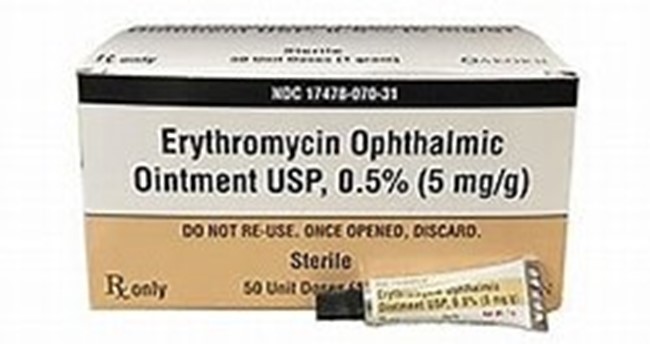A nurse is preparing to administer prophylactic eye ointment to a newborn to prevent ophthalmia neonatorum.
Which of the following medications should the nurse anticipate administering?
Nystatin.
Ceftriaxone.
Erythromycin.
Ofloxacin.
The Correct Answer is C
This is an antibiotic ointment that is applied to the eyes of newborns to prevent ophthalmia neonatorum, a serious eye infection caused by gonorrhea.
Ophthalmia neonatorum can cause blindness if left untreated and can occur even if the mother does not have symptoms of gonorrhea.
Erythromycin is the only drug approved by the FDA for this purpose and is mandated in most states.
Choice A.
Nystatin is incorrect, as this is an antifungal medication that is used to treat oral thrush or diaper rash in newborns, not eye infections.
Choice B.
Ceftriaxone is incorrect, as this is an antibiotic injection that is used to treat systemic gonorrhea infections in adults or newborns, not eye infections.
Choice D.
Ofloxacin is incorrect, as this is an antibiotic eye drop that is used to treat bacterial conjunctivitis in older children and adults, not ophthalmia neonatorum in newborns.
Therefore, choice C is the best answer to this question.

Nursing Test Bank
Naxlex Comprehensive Predictor Exams
Related Questions
Correct Answer is C
Explanation
The proof of pregnancy is in the pregnancy test.
A positive office pregnancy test would confirm the pregnancy.

Choice A, Chadwick’s sign, is not correct because it is not a definitive sign of pregnancy.
Choice B, Hegar’s sign, is also not correct because it is not a definitive sign of pregnancy.
Choice D, Fetal movement felt by the examiner, is not correct because it is not a definitive sign of pregnancy.
Correct Answer is B
Explanation
“6 weeks after fertilization.” Teratogens can begin affecting the developing embryo as early as 10 to 14 days after conception 1.
During embryonic development, there are periods when the developing organ systems show more sensitivity to teratogens.
Choice A is incorrect because 18 weeks after fertilization is not the earliest stage of pregnancy when exposure to a teratogenic agent could occur.
Choice C is incorrect because 12 weeks after fertilization is not the earliest stage of pregnancy when exposure to a teratogenic agent could occur.
Choice D is incorrect because this is not an incomplete question/stem.
Whether you are a student looking to ace your exams or a practicing nurse seeking to enhance your expertise , our nursing education contents will empower you with the confidence and competence to make a difference in the lives of patients and become a respected leader in the healthcare field.
Visit Naxlex, invest in your future and unlock endless possibilities with our unparalleled nursing education contents today
Report Wrong Answer on the Current Question
Do you disagree with the answer? If yes, what is your expected answer? Explain.
Kindly be descriptive with the issue you are facing.
